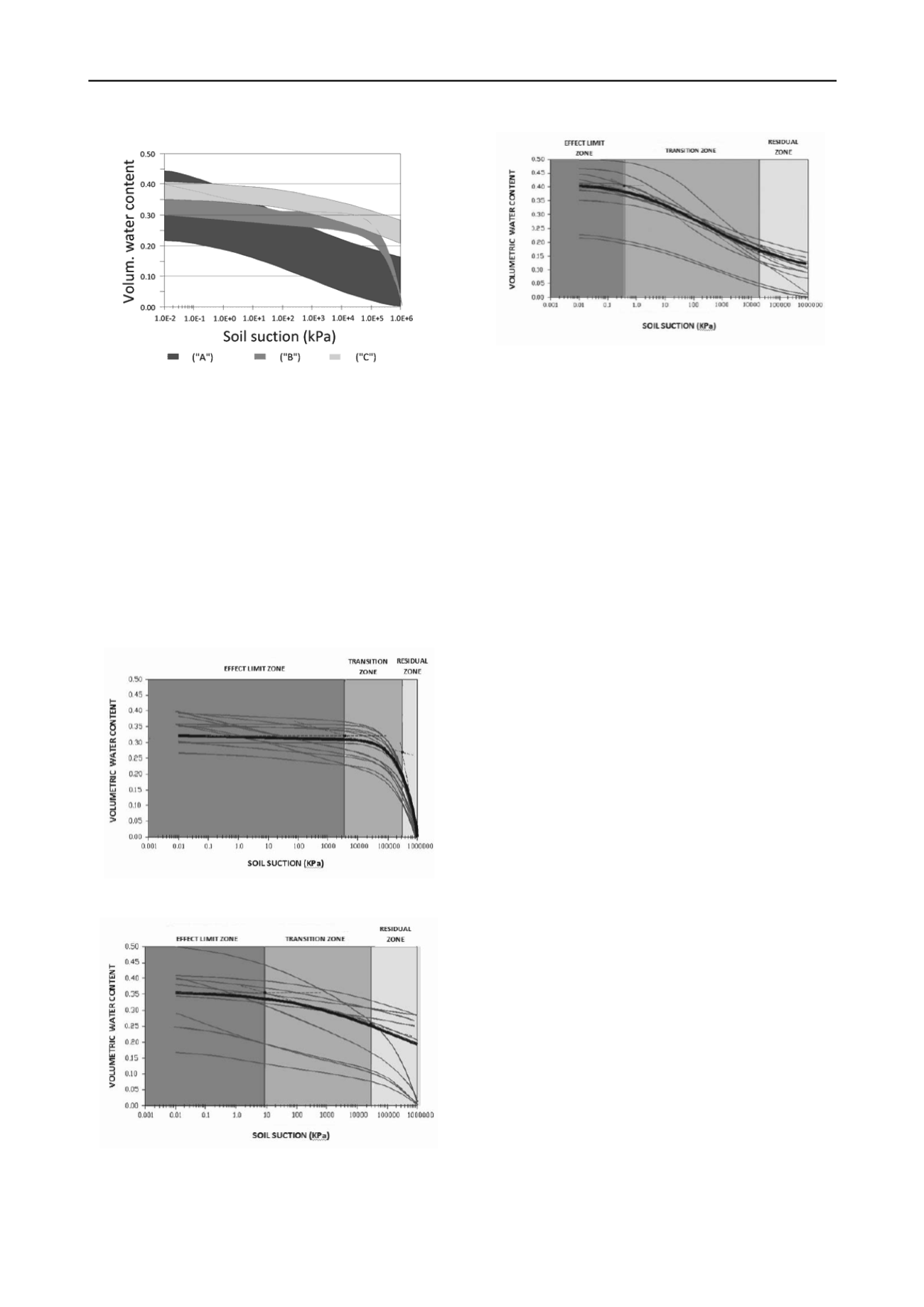
1095
Technical Committee 106 /
Comité technique 106
Figure 7. SWCC ranges for the Ucayali River Watershed.
6 RESULTS ANALYSIS
In general, the considered tropical soils in all Peruvian Amazon
plain were clays, limes, and sands that show mixes that generate
combine soils in each of the five hydrographic watersheds. For
this reason, generalization of the resulted curves is establish
only in its format and tendency adopting type A (Clay), B
(Clay-Lime), and C (Sand) nomenclature.
The comparison made for each watershed, quality of
research soils, geologic origin with respect to the mother rock,
and structural heritage evaluated at site have established
similarities of SWCC that are shown in figures 8, 9, and 10 for
type A, B, and C respectively. These graphs allow the
professional to evaluate behavior predictions that in many cases
will be used for conceptual projects where suction
measurements are difficult to practice (Carrillo-Gil, 2012).
Figure 8. Typical SWCC for Clays (Type A).
Figure 9. Typical SWCC for Clays-Limes (Type B).
Figure 10. Typical SWCC for Sands (Type C).
7 CONCLUSIONS
The results analysis from the SWCC showed that Peruvian
tropical soils not necessarily show uniformity but a variation
and dispersion in accordance with its geological origin and
positioning within the great Amazonian rivers. However,
considering soil type variations that show wide range, it is
found certain similarity of mechanic behavior in accordance
with the establish watersheds for this study.
The data of 1,318 samples was review in order to choose 40
tropical soils used in this study to obtain SWCC of similar
trends for type A, B, and C evaluated for all watersheds. For
type A (clays), it was found the following characteristics: (1)
significant water retention (2) high plasticity (3) air entrance
value occurs in large suctions (4) suction uncertainty for certain
maximum permissible moist content (5) rapid decrease from air
entrance value (6) it does not show inflection point, and (7) nule
transition zone. For type B (clays-limes), it was found the
following characteristics: (1) less plasticity (2) less sudden
rupture (3) constant desorption (4) it does not show inflection
point (5) easy suction determination for the permissible moist
contents, and (6) the air entrance value ranges between values
of curves type A & B. For type C (sands), it was found the
following characteristics: (1) less water retention (2) sudden
rupture until reaching the residual zone (3) it shows inflection
point (4) equal suctions for certain moist contents that belong to
the transition zone, and (5) the limit effect zone can be very
small in some cases, due to the early rupture or air entrance.
It is concluded that the results provide a global vision of the
geotechnical characteristics of non-saturated soils from the
Peruvian tropic humid. These results will allow in the future the
development of new patterns of behavior considering an
adequate evaluation and treatment in order to achieve more
accurate SWCC. This will concede more numerous and better
practical applications for rationalizing special geotechnical
materials in many construction projects through out the entire
Peruvian Amazon region.
8 REFERENCES (TNR 8)
Carrillo-Gil A. 1983. Stability problems in Iquitos, Peru.
VII Pan-
American Conference on Soil Mechanics and Foundation
Engineering. Vancouver, Canada.
Carrillo-Gil A., Carrillo E. and Cardenas, J. 1995. Properties of the
Peruvian tropical soils.
X Pan-American Conference on Soil
Mechanics and Foundation Engineering. Guadalajara, Mexico.
Carrillo-Gil A. and Dominguez E. 1996. Failures in amazon riverbanks,
Iquitos, Peru.
7
th
International Symposium on Landslides,
Trondheim, Norway
.
Carrillo-Gil A. 1997. Peculiarities of tropical saprolitic soils of Peru.
XIV International Conference on Soil Mechanics and Foundation
Engineering, Hamburg, Germany.
Carrillo-Gil A. 2008. Medidas de succion en los suelos saproliticos.
Instituto de Investigacion, Facultad de Ingenieria, Universidad
Ricardo Palma, Lima, Peru.


